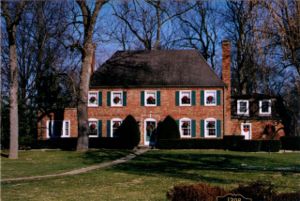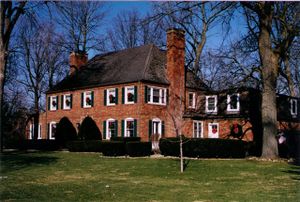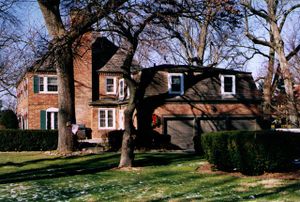Difference between revisions of "Heinzmann-Smith House"
m (→David L. Kiley) |
|||
| Line 13: | Line 13: | ||
About 80% of his practice is devoted to litigation. The law firm Kiley, Kiley, Harker, Michael, and Certain has represented many clients that have played an important role in Marion and Grant County. Some examples include First Federal Savings Bank, Mississinewa Community Schools, Marion Community Schools, Marion General Hospital, General Motors Corp, and Ford Motor Company (Kiley, Kiley, Harker, Michael, and Certain). In 1978 Dr. Gary and Carol Johnston purchased the house. Gary Johnston was a chiropractor and had his own office located at N. River Rd. | About 80% of his practice is devoted to litigation. The law firm Kiley, Kiley, Harker, Michael, and Certain has represented many clients that have played an important role in Marion and Grant County. Some examples include First Federal Savings Bank, Mississinewa Community Schools, Marion Community Schools, Marion General Hospital, General Motors Corp, and Ford Motor Company (Kiley, Kiley, Harker, Michael, and Certain). In 1978 Dr. Gary and Carol Johnston purchased the house. Gary Johnston was a chiropractor and had his own office located at N. River Rd. | ||
| − | Currently, Dr. David J. Aaron, who is also a chiropractor, occupies the office building. In 1992 the new owners of the house were Dr. Steven and Victoria Poe (Transfer Record Card). Dr. Steven Poe works at Marion General Hospital. Today, the current owners are Thomas and Margaret Smith. They both work at McClure's Oil | + | Currently, Dr. David J. Aaron, who is also a chiropractor, occupies the office building. In 1992 the new owners of the house were Dr. Steven and Victoria Poe (Transfer Record Card). Dr. Steven Poe works at Marion General Hospital. Today, the current owners are Thomas and Margaret Smith. They both work at McClure's Oil Corporation located on State Road 37 and 35. |
==Physical Description== | ==Physical Description== | ||
Revision as of 17:42, 9 April 2011
The house located at 1308 N. Sheridan has been the address that many noteworthy people have called home in Marion for seventy years. One of its residents, the home’s builder, helped supply Marion with its building supply needs. The home has some fascinating architectural features that are typical for homes that were build in the same time frame. The home was constructed during a time that for many people it was hard to escape the hardships that they had to face during the Depression. Going to one of Marion’s theaters was a way for people to get out of their depressing surroundings for a couple of hours to enjoy what the theaters had to offer. The second owner of the Heinzmann-Smith House showed his support for the opening of one of Marion’s theaters by hosting a banquet after it’s opening. All of the people that have gotten to live in the Heinzmann-Smith House have left a mark in Marion, no matter how small it might be.Contents
C.C. Heinzmann
The first home built in the Northwood subdivision was built by Clarence C. Heinzmann (First Home Built in Northwood). C.C. Heinzmann was born in Noblesville, Indiana on January 13, 1890, and moved to Marion in 1917. With his wife Irene, they had three children, George, Betty, and Mary. (C.C. Heinzmann Dies Following Short Illness). His father, G. W. Heinzmann established in 1917 or 1918 the Heinzmann and Son Lumber Co. located at 1740 West First St. (Citizens Historical Association). After he moved from Noblesville to Marion, C.C. Heinzmann became an active member in his father’s business hence the name Heinzmann and Son Lumber Co. C.C. Heinzmann became a partner in the firm and was active in the managing of the company. He was well-known in Marion and Grant County for his affliction with the building business (C.C. Heinzmann Dies Following Short Illness). The company was a retail lumberyard that carried “building materials of all kinds” and did general contracting as well (City Directory 1948).
The Heinzmann family operated the business until 1938. Then in 1938 they sold their interest to the next owners who changed the company’s name to the West Side Lumber Co. The West Side Lumber Co. handled a complete line of lumber and builders’ supplies paints, oils, and builders’ hardware in February 21, 1948. The company also consisted of a planing mill. In 1948 the business covered the areas within a 30-40 mile radius and employed 12-15 persons (Citizens Historical Association).
C.C. Heinzmann died at the age of 48 in Marion General Hospital on April 25, 1938. The second owner of the house was Robert P. Kiley. Robert P. Kiley was the president of Grant Beer Distributors located at 1117 Spencer Ave (City Directory 1958).
David L. Kiley
The following owner was David L. Kiley. Kiley was born in 1928 and is presently a partner at Kiley, Kiley, Harker, Michael, and Certain which is located at 300 W. 3rd Street. David Kiley attended Georgetown University Law Center in Washington D.C.
About 80% of his practice is devoted to litigation. The law firm Kiley, Kiley, Harker, Michael, and Certain has represented many clients that have played an important role in Marion and Grant County. Some examples include First Federal Savings Bank, Mississinewa Community Schools, Marion Community Schools, Marion General Hospital, General Motors Corp, and Ford Motor Company (Kiley, Kiley, Harker, Michael, and Certain). In 1978 Dr. Gary and Carol Johnston purchased the house. Gary Johnston was a chiropractor and had his own office located at N. River Rd.
Currently, Dr. David J. Aaron, who is also a chiropractor, occupies the office building. In 1992 the new owners of the house were Dr. Steven and Victoria Poe (Transfer Record Card). Dr. Steven Poe works at Marion General Hospital. Today, the current owners are Thomas and Margaret Smith. They both work at McClure's Oil Corporation located on State Road 37 and 35.
Physical Description
While some French and Dutch influence can be seen throughout the Heinzmann-Smith house, the most dominating architecture is clearly Georgian. The shallow pitch roof is borrowed from French architecture while the flaring eve, that help protect the entrances of the home from rain, snow, and other weather conditions, is borrowed from Dutch architecture. In Georgian architecture, symmetry and balance play an important role in the design of the house. The Heinzmann-Smith residence is very well balanced and symmetrical. The influence of symmetry can clearly be seen in the two chimneys that are on both sides of the home. In the southern colonies during the 18th century, the primary materials for Georgian homes were red brick, tall chimneys, and white wood trim around the front door, all of which can be seen in the Heinzmann-Smith residence. Therefor, the home’s primary architecture is southern Georgian with a few characteristics of European influence (Architectural Study).The original house plans included a living room, a large solarium, dining room, kitchen, and breakfast room, four bedrooms, two baths, and a three-car garage (First Home Built in Northwood). What today is a home office, the present owners suspect was the original breakfast room because of the great morning light that they get through the window in the morning. The present owners have also added shutters after they found a picture of the house when it was first built. The current owners also brought back to life the original hardwood floors in the dining room. The servants quarters is today a bedroom and bath for one of the Smith’s two children. The quarter has a small staircase leading down to the kitchen and the laundry room is adjacent to it. When the house was constructed in 1932, there were no public sewers that far north so a well was built beneath the front porch that is accessible by the basement. The homeowners still use the well today for their outside water needs. In the front entry-way there is a bench that has a steam heater behind it that can be used to keep coats or shoes warm. Other unique aspects of the house include a light switch in the master bedroom, which turns on a light near the entry-way which was typical of a house built during the 1930’s as a security measure. During the 1930’s wood paneling was often used on the lower half ofthe dining room walls which can be seen in the home has as well (Smith).
According to David Kiley, the fireplace in the basement had a built in button that when pushed, would open a cabinet used to hide alcohol. This was necessary for anyone that wasn’t willing to abide with the National Enforcement Act. It started in January 1920 when the Act forbade the manufacture and sale of alcohol with the content greater then 0.5 percent. The Act was repealed in April of 1933 because of the great opposition that it caused (Prohibition and Temperance). Residents in Marion at the time of the Prohibition Era avoided getting caught with breaking this act. In Marion punishment for those caught with alcohol that had an alcohol content of 0.5 percent or greater faced a punishment that consisted anywhere from a $100-200 fine and 60-90 days on the state penal farm (Suspect Fined for Possession in Police Raid).Perhaps the most unique aspect of the home is not the house itself but the property on which it stands. The property lies in two different townships. The house lies mainly in Pleasant Township while most of the yard is located in Center Township (Smith, Thomas). Pleasant Township’s first settler was Goldsmith Gilbert who established a trading post on the river about a mile above Sutton’s Ford in 1823. It is the oldest township in the county. Center Township was so named because of its central location in the county. Martin Boots made the first purchase of land in Center Township on October 19, 1825 (Grant Count Junior Historical Society).
Conclusion
The first owner of the Heinzmann-Smith house was its builder, Clarence. C. Heinzmann. C.C. Heinzmann’s lumber company provided building materials for some of Marion’s construction needs. The architecture of this Georgian style house gives visitors little clues as to around what time period it was constructed. Before the building of the house, the Depression had started and it lasted well beyond the home's completion. The Theaters in Marion gave residents a way to unwind and perhaps, for a few short hours, forgot about the hardships that they were facing. Robert P. Kiley, the second owner of the Heinzmann-Smith house, supported the opening of one of Marion’s four theaters during the 1930’s.The Heinzmann-Smith house has been a home to many people that have, in their own way, given back to their community. Whether it be in providing the community with building supplies, supporting it’s theaters, or simply by living and working in Marion, the residence that have lived in the Heinzmann-Smith house have all contributed parts of themselves into the ever changing Marion.
Works Cited
- Assessment Office. Administrative Information. No. 0336-101-056.000-25.
- Bunish, Steve. The Golden Age of Marion. Editor: Stephanie Bunish Fuller: 3.
- “C.C. Heinzmann Dies Following Short Illness.” Marion Leader Tribune. 26 Apr. 1938:1.
- Citizens Historical Association: 21 Feb. 1948. No. JCC/DLA.
- “Dry Violator is Sentenced.” Marion IND.,Chronicle 15 Oct. 1931: 14.
- Durbin, Winfield. “Theater Opening Is Mark Of Confidence.” Marion Chronicle-Tribune 26 Mar. 1933.
- Grant County Junior Historical Society. A Century of Development. 1937.
- “Heinzmann, Clarence C.” Polk’s Marion (Grant County, Ind.) City Directory. Indianapolis: R.L. Polk & Co., Publishers, 1931.219.
- “First Home to Be Build At Northwood”. Marion Sunday Leader Tribune. 11 May 1930. 2:1.
- “Kiley, Kiley, Harber, Michael, and Certain.” 16 Dec. 2001 <http://www.kileylaw.net/profile.asp?wld_id=2295146>.
- “Prohibition and Temperance.” The Reader’s Companion to American History: 871.
- “Settling Up.” Marion Chronicle Tribune 30 June 1947: 3:19.
- Smith, Thomas. Personal Interview. 10 Dec. 2001.
- “Suspect Fined For Possession In Police Raid.” Marion Chronicle 9 Oct. 1931: 4.
- “Tom Smith Home Report.” Architect in Kokomo.
- Transfer Record Card. Grant County, Indiana. Parcel No.: 02-31-202-032-16
- Walker, Rebecca. Introduction. The History of the Grant County Indiana Women’s Christian Temperance Union. 1998.
Credits
This article was written by Katharina Fischer and submitted on January 16, 2001 for Mr. Lakes' and Mr. Munn's classes at Marion High School.


